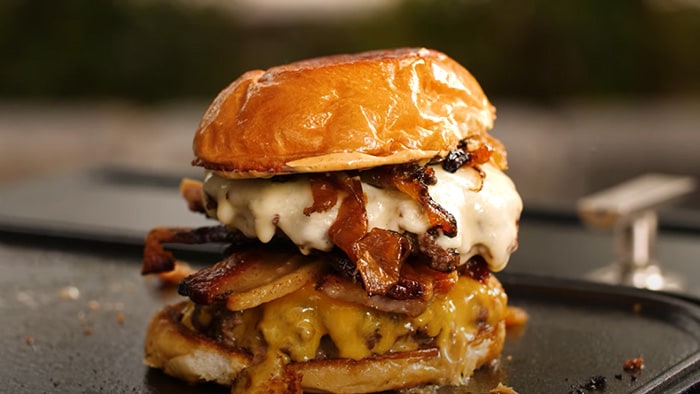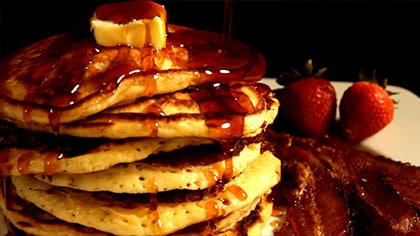
Don’t let our name fool you: we have a deep appreciation for every type of outdoor cooking, not just BBQ grilling. Our favorite alternative is none other than flat top grilling, a simple yet versatile cooking style fit to handle anything that could otherwise be made on a traditional grill — and then some. There’s a reason flat top grills are extremely common in commercial kitchens, and it’s not just because using one makes you look like you’re a celebrity chef hosting your own cooking show.
No, seriously: searing steaks and burgers is one thing, but flat top griddles (we use the terms interchangeably around here) allow you to sauté stir fry, flip flapjacks, or prepare an entire breakfast hash, all on a single cooking surface. Oh, and did we mention you can get cookware involved too? Cooking on a flat top grill is one of the easiest ways to expand both your menu and entertainment capabilities, and today we’re going to show how to get the most out of these awesome outdoor powerhouses.
What’s the Difference Between a Flat Top Griddle and a Gas Grill?
Though both cookers use adjacent gas burners, the key difference comes down to the way the cooking surface of each is designed. Flat top grills and griddles have wide, flat cooktops covering the burner flames, while grills feature lined grates that allow food to have direct flame contact. For flat top grills, that means no flare-ups, better end-to-end temperature evenness, all-over caramelization, and the ability to cook items like eggs or pancakes that would fall through the grates of a traditional grill (just trust us on that one).
Of course, there are a few important trade-offs that come with the design differences: food cooked on a flat top griddle won’t receive bold sear marks or flame kisses, nor will it carry the classic BBQ flavors we expect from a grill. That being said, we’re not sure it’ll matter all that much when you’re cruising through a batch of burgers with no fear of flare-ups or cranking out breakfast sandwiches for the whole family.
Cooking on Flat Top Grills
We’ve got some good news and some bad news. The good news: cooking on a flat top griddle is extremely simple. The bad news: … actually, there is no bad news! (It’s called “dramatic tension,” and it’s not always easy to craft around topics like “cooking on a griddle.”) The truth is it’s a lot like cooking on a gas grill, where managing time and temperature via burner control are crucial to success. Mastering the griddle, though? We know a thing or two about that, and we’re eager to share our tips for flat top grilling so you can take your culinary chops to the next level.
Use the Right Seasoning & Cooking Oils

While seasoning a griddle is mostly about maintenance, many backyard chefs choose to apply oil for seasoning across the flat top surface before they start cooking — and ultimately use oil during the process anyway. Oils with a high smoke point (425°F–450°F) are best for the protective, non-stick seasoning layer, but any cooking oil will do when it’s time to start flipping patties and sautéing veggies. Trying to knock out two birds with one (Black)stone? Our experts recommend coconut and avocado oils for their high smoke point and utility as a cooking aid. And if you’re making fatty beef or bacon, rendering a bit of fat to use as de facto griddle oil is a great way to earn serious cred with your guests.
Cook in Heat Zones
Despite flat top griddles being designed for even temperatures, you can manipulate their heat to your advantage in the same way you’d grill with dual cooking zones. Simply set one burner to a higher setting than the other(s), and you’ve got an area for searing next to a space for gingerly cooking tender veggies or keeping your handiwork warm while you complete the rest of the meal. Cooking in zones is especially useful for popular griddle dishes like breakfast hash or stir fry, which have multiple ingredients that finish at different rates. Just be aware that zones on a flat top grill won’t be as distinct as those on gas grills with heat-zone separators.
Cooking Tools Are Your Friend

Your flat top grilling tools should be long-handled — all that sizzling oil and rendered fat has a tendency to splatter — and should usually be larger than your typical kitchen utensils. But griddle tools extend far beyond simple spatulas and tongs; in fact, our experts have gone so far as to call the humble melting dome accessory “indispensable” in your quest for perfectly gooey cheese and steamed items. Also, don’t overlook the power of basic squeeze bottles allowing you to season the cooktop or add cooking oil to your food without getting burned by splatter.
Can You Use Cookware on a Griddle?
You can use any type of outdoor cookware, be it pots, pans, or Dutch ovens, directly on the flat top grill surface to push cooking versatility beyond your wildest dreams! Boil pasta, steam veggies, parboil potatoes, start your stew base, and generally perform almost any task you’d otherwise handle in your indoor kitchen — while keeping the party outside. A word of warning, though: never use cast iron cookware flat top grills. Cast iron has a bad habit of both scratching griddle cooktops and depositing traces of iron, which can quickly invite rust into the cooking surface.
Clean As You Go
What we’re about to describe is only part of the griddle-cleaning routine, but it’ll save precious time once dinner’s done while also making things easier for you as you show off your griddle game. Using a scraping tool, simply scrub food residue from back to front (or wherever your flat top grill’s grease trough is located). Clearing the debris and gristle as you go not only provides you with more cooking space for your soon-to-be memorable meal, but also means you’ll have less to scrape away after those memories have been made.
Best Flat Top Grill/Griddle Recipes to Try
See, pretty simple! We’re excited to see you practice what you’ve learned about cooking on a flat top grill, and we have just the griddle recipes to help you hone the craft. Better yet, you’ll get to feast on game-changing griddle goodies like flavorful French toast sandwiches, the legendary Smashburger®, and the meanest breakfast hash you’ve ever encountered. When all’s said and done, we think you’ll understand why we enjoy cooking on a gas griddle as much as we love grilling.



















































































































































































































































































































